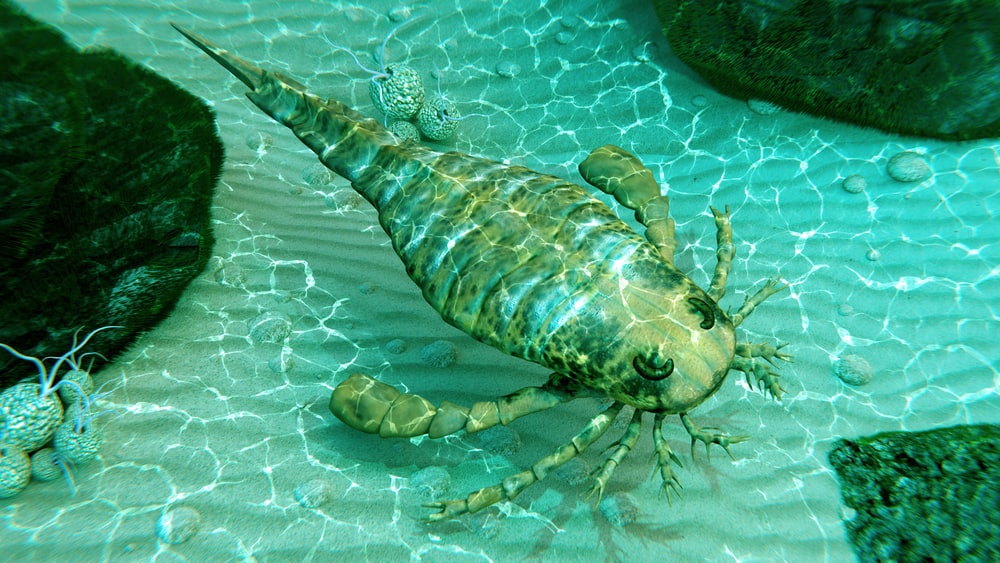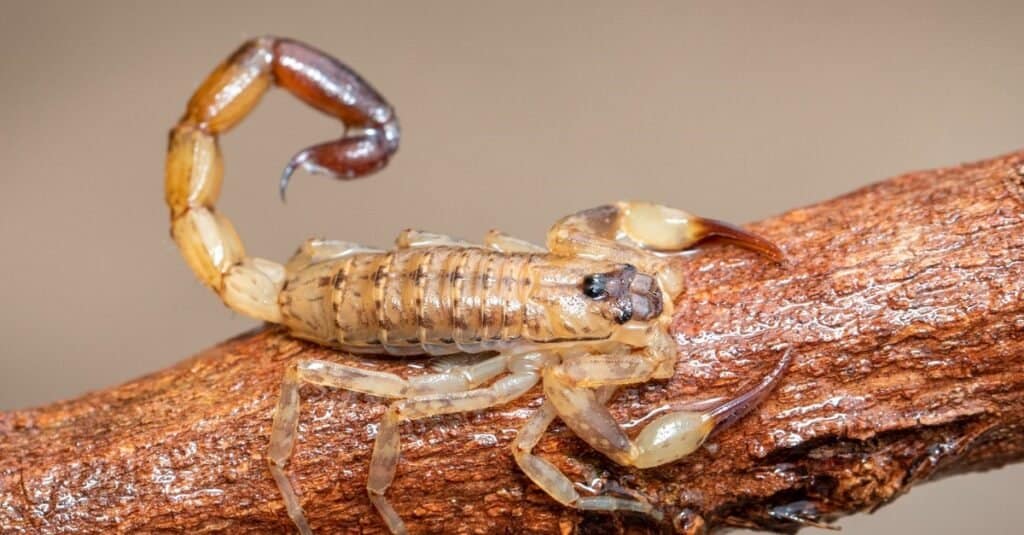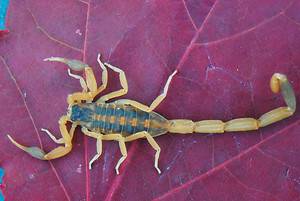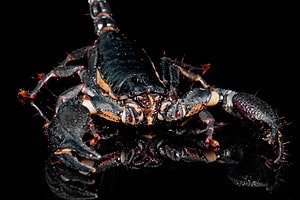Ancient sea scorpions belong to a group of large arthropods called eurypterids. These ancient animals are the largest arthropods in history. Their name comes from their resemblance to today’s scorpions. They lived as far back as 444 million years ago.
Eurypterids were predators to be feared. Some even evolved claws, which they used for grasping onto objects and prey. We will discuss what a eurypterus is, when this ‘sea scorpion’ existed and when it went extinct. We’ll describe this animal in detail and discover how it must have lived millions of years ago.
Size and Description of the Ancient Sea Scorpion

An illustration of eurypterus exploring sea floor. Eurypterids are related to arachnids and include the largest known arthropods to have ever lived.
©Aunt Spray/Shutterstock.com
Eurypterus is described as a giant genus of sea scorpion. They were able to grow as long as 2.5 meters, but many species were smaller. This animal gets its name from the Greek language, meaning ‘wide wing.’ They’re called sea scorpions due to their resemblance to scorpions and the similar way they used their tails. Their tails were weapons used to attack and shred prey to bits. They attacked their prey with a spike at the end of their tail, much like a modern-day scorpion does. Eurypterus’ head was armor protected.
- Length – about 1.3 meters average
- Attributes – spiked tail, armored head, back legs for paddling
- Classification – Eurypterida, Euryteridae, Arthropoda
This animal’s body was divided into three parts. The forward body part is the prosoma. This region forms the thorax and the head. There are two large eyes and two smaller ones on the head. What constitutes the mouth is located under the head and linked with a pair of strong pincers.
Eurypterus’ pincers would have served as claws to grab prey. They used it to tear their prey apart to munchable bits.
Opisthosoma is the second segment of the eurypterus body. This body segment includes the tail region. This region has twelve parts that are moveable with a sharp telson. Unlike a modern scorpion, the tail end has no venom. It may have used gills to breathe. These gills are called book lungs because they look like book pages in the abdominal region.
Eurypterus had hind legs that served as paddles for swimming. The other legs were for walking on land and seabeds. They would have walked on shallow seabeds, searching for animal carcasses to feed on. While they looked like modern-day scorpions, they are not actually related.
What Did Eurypterus Eat?
Eurypterus was a carnivorous animal. This animal hunted and ate other animals using its pincers and spiked tail. Their teeth were sharp, and could easily grab prey with their claws. These sharp and strong claws helped them firmly hold on to their prey.
Their diet included fish and other marine animals. They also could have been cannibals that ate smaller versions of their genus. Eurypterids may have also been scavengers, searching shallow sea floors for carcasses.
When and Where the Eurypterus Lived
Eurypterus was a marine invertebrate that evolved about 444 million years ago. This period was the Silurian period, the third of the Paleozoic era. This era was the age of ancient life. Rising sea levels and low landmass made these animals evolve as land and marine animals.
Eurypterus lived in shallow waters. They were found in the shallow seas that covered parts of New York during the Paleozoic era. Fossils of other species have been found in Estonia, North America, and East Eurasia. These fossils show that eurypterus lived and hunted primarily in shallow waters.
Threats and Predators of the Ancient ‘Sea Scorpion’

Jaekelopterus was the largest member of its genus.
©Dew_gdragon/Shutterstock.com
Eurypterids were successful predators of their time. They were amphibious animals that were effective on land and in water. These large, scorpion-like creatures could grow as large as 2.5 meters (8 feet) in length. While there is no evidence of what might have threatened eurypterus, there is speculation that it could have been hunted by bigger members of its genus.
Eurypterid’s diet included other smaller eurypterids. Comparing the size of the average eurypterus to the largest member of its genus, the jaekelopterus, most eurypterus species were much smaller animals. Smaller eurypterus species were probably preyed on by larger genus members.
Where Eurypterus Fossils Were Found

Tainan City, Taiwan: Eurypterus remipes fossil at Fossil Hall of Tainan City Zuojhen Fossil Park.
©topimages/Shutterstock.com
Eurypterids are usually found on coasts and inland waters around North America, western Asia, and Europe. The first eurypterid fossils were found in 1818 at the Bertie formation, New York. This fossil was misidentified as a catfish but later corrected in 1825 and named ‘Euryptus rimpes.’
In 1835, Richard Harlan discovered the ‘Euryptus lacustris’ in New York. ‘Euryoterus tetragonophthhalmus’ was discovered in Estonia in 1858. Jan Nieszowski made this discovery. The Estonian fossils retained more details than other discoveries. Eurypterus remipes was discovered in Taiwan. Eurypterus is the most common of the eurypterid fossils that have been discovered. They make about 95% of eurypterid fossils found.
Extinction: When Did It Die Out?
Eurypterus existed about 444 million years ago when anthropods evolved and ruled the seas. Most of those in this period went extinct due to the extinction called the ‘Great Dying.’ This extinction event destroyed about 95% of marine life and about 70% of land organisms.
Carbon rapidly released into the earth’s atmosphere initiated the Great Dying. Volcanoes released billions of tonnes of carbon. This carbon release caused global warming, which caused an inability to breathe for these animals. These factors led to the extinction at the end of the Permian period.
Similar Animals to the Eurypterus
Eurypterus is famously called ‘sea scorpion,’ mainly due to its looks. It features a modern-day scorpion’s physique and techniques. However, eurypterus belong to a different genus of animals. They are anthropods like scorpions but part of a different species.
Eurpyterus is related to other creatures that exist today. These creatures are not nearly as dangerous as the erypterus was. Animals that are similar to Eurypterus include:
Horseshoe Crab
This animal is a shallow water arthropod that’s a close relative of the eurypterus. They are living fossils that evolved about 300 million years ago and have been around ever since. They feed on invertebrates like works as they dont have jaws.
Jaekelopterus
This is a relative of the eurypterus that existed in the Silurian period. They are a much larger species of the eurypterid genus and can grow as long as 8 feet. They had claws like today’s scorpions and a shark tail with armor.
Scorpion

While eurypterids resemble modern-day scorpions, they actually aren’t related.
©iStock.com/yod67
Scorpions are arthropod creatures that have lived for about 300 million years. They have claws for grasping and a five-sectioned tail that has a venomous telson at the end. Scorpions have an interesting habit of dancing before they mate. The male walks the female around and finds a suitable spot to deposit his sperm. Then, he guides the female over it so she can take the sperm.
Spider
Spiders are arachnids that are closely related to eurypterids. They have two body sections. The anterior region has the fangs, eyes, palps, and legs, and the posterior region is the abdomen. Most spiders are venomous. They use this venom to paralyze their prey.
Tick
Ticks are arachnids that are related to spiders. As an ectoparasite, they feed on both organisms and plants. All arachnids have eight legs, and ticks are no exception. They possess a behavior called phoresy. This behavior involves dispersing by latching onto animals with more mobility for a better ride. About 850 known species of ticks exist around the world.
Conclusion
Euryoterus was a fearsome creature during its time. This ancient sea scorpion belonged to a genus of prime predators and ruled the sea. Though it lived a marine life, species of eurypterids also evolved the ability to live on land.
Eurypterus is not the largest of the eurypterids family, as that is the jaekelopterus. The eurypterus can grow to enormous sizes, with a recorded 4.3 feet long fossil. An arthropod that long, with a long telson and claw-like pincers sounds like a fierce creature for ancient and modern times.
The photo featured at the top of this post is © Aunt Spray/Shutterstock.com
FAQs (Frequently Asked Questions)
When was the Eurypterus Alive?
The Eurypterus lived during the Silurian period of the mid-Paleozoic era. They lived between $44 million years ago to about 418 million years ago. This was after a mass extinction happened in the late Ordovician period.
How Big was the Eurypterus?
The Eurypterus could grow as long as 9 inches. Some larger individuals can grow as long as 24 inches. The largest individual Eurypterus fossil discovered was about 4.3 feet long.
Was the Eurypterus as big as an average human?
No, the Eurypterus was not as big as an average human. An average human height is 5 ft 9 inches, and the largest individual Eurypterus fossil is about 4.3 feet. It is of considerable length but not as big as the Jaekelopterus, which could grow to about 8 feet long.
Were they marine animals?
The Eurypterus was likely a marine animal due to the shallow locations where its fossils have been discovered. There is also speculation that it was an amphibious animal that spent more time in shallow waters than on land. Eurypterids evolved to survive and live on land over time. It is evident in today’s close relatives to the Eurypterud.
Thank you for reading! Have some feedback for us? Contact the AZ Animals editorial team.






